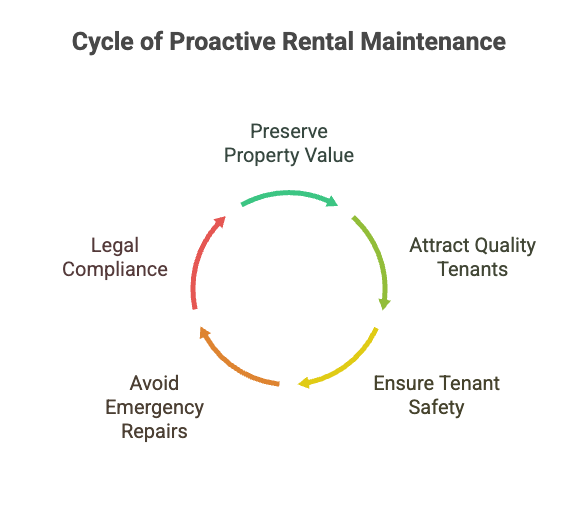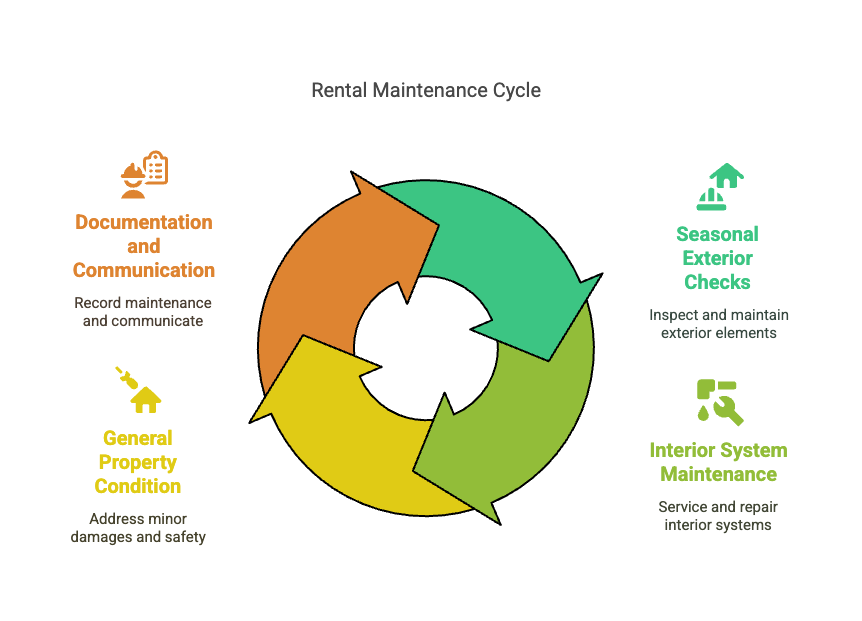Owning a rental property can be a fantastic investment, offering a steady stream of income and long-term appreciation. However, to truly maximize your returns and keep your tenants happy, you need to maintain & upkeep your Rental Property. Neglecting regular maintenance and upkeep can lead to costly repairs, tenant dissatisfaction, and ultimately, a negative impact on your business.
This blog will walk you through the best practices for maintaining your rental properties, providing a comprehensive landlord checklist to ensure your investment remains in top shape.
Why Maintenance Matters for Rentals
Think of your rental property as a living asset that requires consistent care. Here’s why a proactive approach to maintenance is crucial:

- Preserves Property Value: Regular upkeep prevents minor issues from escalating into major, expensive problems, thereby protecting and even enhancing your property’s market value.
- Attracts and Retains Quality Tenants: Well-maintained properties are more appealing. Happy tenants are more likely to renew their leases, reducing vacancy rates and turnover costs.
- Ensures Tenant Safety and Comfort: A safe and functional living environment is a landlord’s responsibility. Proactive checks ensure all systems are working correctly, minimizing risks and maximizing comfort.
- Avoids Emergency Repairs: Catching issues early means you can schedule repairs at your convenience, often at a lower cost, rather than dealing with urgent, after-hours emergencies.
- Legal Compliance: Many jurisdictions have regulations regarding property habitability. Regular maintenance helps ensure you meet these legal obligations.
Essential Checklist for Maintenance and Upkeep of the Rental
To simplify your rental upkeep efforts, here’s a comprehensive checklist covering key areas. Aim to address these items regularly, ideally on a seasonal or annual basis.

1. Seasonal Exterior Checks
Roof Inspection: Annually check for loose, cracked, or missing shingles. Look for signs of water damage or leaks in the attic or ceilings after heavy rains. A damaged roof is a common source of leaks that can lead to major repairs.
Gutter and Downspout Cleaning: Clear gutters of leaves and debris at least twice a year (spring and fall) to ensure proper water drainage away from the foundation. Clogged gutters can lead to water damage to the roof, walls, and foundation.
Foundation Inspection: Look for cracks, signs of moisture, or pest entry points around the foundation. Ensure proper grading to direct water away from the building.
Landscaping and Drainage: Trim trees and shrubs away from the house to prevent damage and maintain clear pathways. Ensure proper drainage to avoid water pooling near the property.
2. Interior System Maintenance
HVAC System Servicing: Schedule professional HVAC (heating, ventilation, and air conditioning) maintenance annually. This ensures efficiency, extends the lifespan of the units, and prevents breakdowns. Remember to replace air filters every 1-3 months; clogged filters make the system work harder and can lead to costly repairs.
Plumbing Checks: Inspect faucets, toilets, and pipes for leaks or drips. Address any running toilets or slow drains promptly. Consider flushing the water heater annually to remove sediment and ensure efficient operation.
Electrical System Review: Check outlets, switches, and light fixtures for any signs of wear or malfunction. Ensure all smoke and carbon monoxide detectors are working correctly and replace batteries annually. This is a critical safety measure.
Appliance Inspection: If your property includes appliances, regularly check their condition. Clean refrigerator coils, inspect washing machine hoses, and ensure ovens and dishwashers are functioning properly.
3. General Property Condition & Safety
Pest Control: Conduct regular inspections for signs of pests (insects, rodents). Address any infestations immediately to prevent them from spreading and causing discomfort to tenants.
Caulking and Grout: In bathrooms and kitchens, inspect caulk and grout lines for cracks or mildew. Re-caulk as needed to prevent water penetration and maintain a fresh appearance.
Walls, Ceilings, and Floors: Patch small cracks or holes in drywall and touch up paint as necessary. Inspect flooring for loose tiles, damaged carpets, or squeaky floorboards. Addressing these minor issues prevents them from worsening.
Doors and Windows: Check for proper sealing around doors and windows to prevent drafts and improve energy efficiency. Ensure locks are secure and windows open and close smoothly.
4. Documentation and Communication
Maintenance Log: Keep a detailed record of all maintenance performed, including dates, costs, and the person responsible for the work. This log is invaluable for budgeting, tax purposes, and demonstrating due diligence.
Tenant Communication: Establish clear channels for tenants to submit maintenance requests. Respond promptly and communicate clearly about repair timelines. Regular, scheduled inspections (with proper notice) can also help identify issues early and foster good landlord-tenant relations.
ProTip: Use RentOk to keep the tab and manage all the maintenance requests and repairs with logs.
Emergency Contacts: Have a list of reliable contractors (plumbers, electricians, HVAC technicians) for emergency repairs.
FAQs
- How often should I perform property inspections?
It’s recommended to perform a thorough property inspection at least once a year. Some landlords prefer semi-annual or even quarterly checks, especially for newer properties or those with higher tenant turnover. Move-in and move-out inspections are also crucial. - What is the difference between routine maintenance and emergency repairs?
Routine maintenance involves scheduled tasks like HVAC servicing, gutter cleaning, or filter changes, aimed at preventing issues. Emergency repairs are unexpected, urgent fixes required due to sudden breakdowns or hazards, such as burst pipes or electrical failures. - Can I charge tenants for maintenance?
Generally, landlords are responsible for maintaining the structural integrity and essential systems of the property. Tenants are typically responsible for minor upkeep and damages caused by their negligence. The lease agreement should clearly outline these responsibilities. - Should I hire a property manager for maintenance?
Hiring a property manager can significantly reduce your maintenance burden. They often have a network of trusted contractors, handle tenant requests, and oversee repairs, making it a good option for busy landlords or those with multiple properties. - How can technology help with property maintenance?
Property management software can streamline maintenance by allowing tenants to submit requests online, enabling landlords to track progress, assign tasks to contractors, and maintain digital records of all repairs and expenses. This improves efficiency and communication.
Conclusion
The effective way to maintain & upkeep your Rental Property is the cornerstone of successful rental property ownership. By adopting a proactive approach and utilizing a comprehensive landlord checklist, you can ensure your properties remain safe, functional, and appealing. This not only protects your investment but also fosters positive relationships with your tenants, leading to long-term success in the competitive rental market. Remember, a little effort in rental upkeep goes a long way in securing your financial future.

